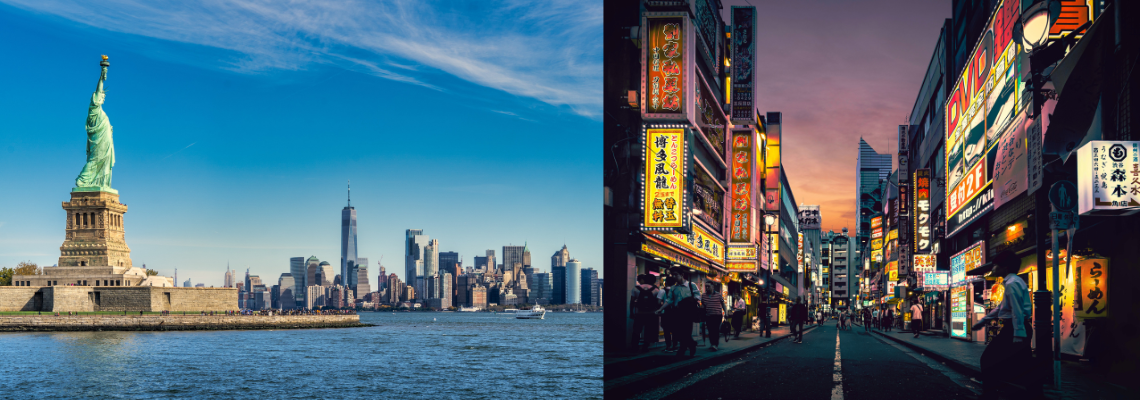5 cities leading the way in water resilience
As the global population continues to grow, accessing and managing water resources is becoming increasingly challenging. We highlight five international cities that are leading the way in water resilience, exploring the techniques they are using and how they are measuring success.
1. New York, US

New York's constantly changing weather patterns have brought the city's infrastructure to its knees more than a few times. The catastrophic damage caused by Hurricane Sandy in 2012 led to the government initiating the Big U storm project. Over the past few years, this multi-billion dollar project aimed at protecting the city's infrastructure has gained a lot of momentum.
The Big U Storm project is a venture aimed at addressing the storm-induced risks to Lower Manhattan which are due to strong storm surges, the rising sea level, and climate change. The project comprises 10 miles of protective infrastructure and has two main objectives. The first objective is to protect the infrastructure and properties of Lower Manhattan from the inner harbour, and the second is to enhance the overall liveability of the neighbourhood.
Providing multiple layers of protection
As part of the overall project there are several smaller sub-projects that target different areas and infrastructures, including Battery Park, East and West side coastal areas, and other public infrastructure. New York City's infrastructures are incredibly multifarious and complicated, the new initiative is aimed at providing multiple layers of protection for critical infrastructure such as hospitals and transportation.
Led by the New York Economic Development Corporation in a public partnership with the New York City Department of Parks and Recreation, the Big U Storm project has a budget of $2.7 billion. It has also received designated funds from the National Disaster Resilience Competition and the Mayor's office along with lots of positive feedback.
Certain sections of the infrastructure, including the implementation of a flood protection park in East Harlem, a new marine transfer station that handles waste management, and the completion of several parks have been completed to date. The next phase of the project includes the development of public waterfront plazas, new Staten Island ferry landings and terminals for various ferry routes and strategic infrastructure planning for East Side and the South Street.
The Big U project is an ambitious initiative guaranteeing a more resilient, safe, and sustainable future. It has gained tremendous momentum and has received constant support from various public and private sector bodies. Its future looks bright, and hopefully, it will help protect New York from similar catastrophes in the future.
2. Wuhan, China
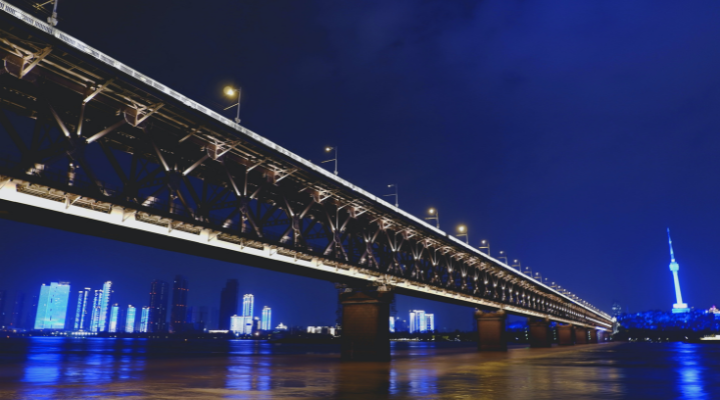
China's rapid modernisation and urbanisation over the last few decades have taken a heavy toll on the country's natural resources, especially water. The country's water crisis is well-known, with many cities facing chronic water shortages, water pollution, and incidents of flooding. To combat these challenges, the Chinese government launched an initiative in 2013, known as ‘sponge cities’.
A sponge city is designed to absorb, clean and reuse water mimicking the water management system of natural sponges. Sponge cities are built with green infrastructure, such as wetlands, parks, and permeable pavements, which enable rainwater to infiltrate into the ground for storage and recharge of the groundwater table.
A nature based approach
Located in the Hubei Province of China, Wuhan is a sponge city that has been touted as a leading example of a nature based approach to increasing urban resilience to climate change. The city has initiated 389 separate sponge city projects covering 38.5 square kilometres of the city, including urban gardens, parks and green space designed to allow water to infiltrate during regular precipitation and to direct water away from urban areas during flooding. Other projects include artificial lakes that draw water away from populated areas and water channels that can safely handle large volumes of water during flooding.
“Wuhan’s model is now being recreated in other towns and cities worldwide.”
The city’s nature-based approach to resilience was more than US$600 million cheaper than upgrading its drainage system. There were also significant co-benefits, including improved local air quality, biodiversity and conservation benefits, health and lifestyle benefits, and increased land value. The city’s Yangtze River Beach Park showcases this: temperatures in the park can be three degrees cooler than in the city; the vegetation sequesters 724 tonnes of carbon annually; and the value of land in surrounding areas has more than doubled to US$1,471 per square metre.
Wuhan’s model is now being recreated in other towns and cities worldwide, including the Berkshire town of Slough in the UK which recently announced it had secured a share of a £150 million government funding to improve waterway defences and coastal resilience by recreating Wuhan’s "sponge city" concept.
3 - Tokyo, Japan
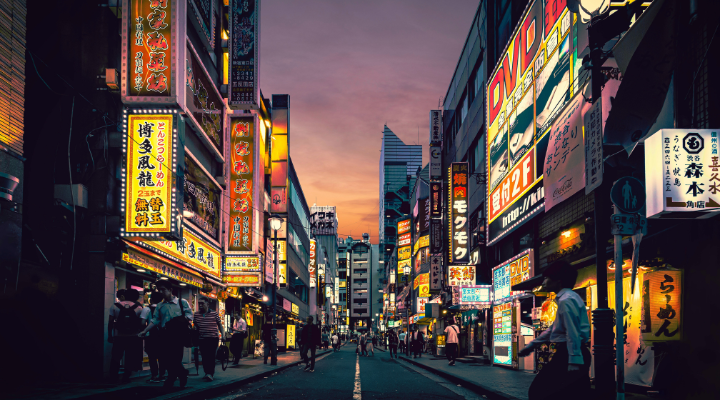
Tokyo is known for its high population density and frequent heavy rainfall leading to flashes of deadly floods and landslides. Urbanisation has put extra pressure on Tokyo’s rivers, making the city vulnerable to water hazards. However, the authorities found an innovative solution to reduce flooding and landslides in Tokyo, the creation of an underground network of tunnels and reservoirs allowing water to flow underground during heavy rainfall, reducing the flood risk.
Tokyo’s Tunnel and Reservoir Network (TRN) is an extensive network of underground tunnels and reservoirs, spanning 6.3 km², that can hold up to 630,000 m³ of water. The channels redirect rainwater to underground storage pools, thereby reducing flood risk in the city.
The network, built after the devastating floods in 1990, cost an estimated $2.7 billion and it is considered the world’s biggest water storage facility. The tunnel and reservoir network has reduced the likelihood of flooding in the city for up to 70 years, making Tokyo a model for countries tackling similar challenges.
Reducing flood impact
The TRN also has a unique operation system that's triggered in time of heavy rainfall, where the tunnels start to pump water into underground reservoirs. The twin reservoirs named 'Meguro Gawa' and 'Edogawa' hold approximately 500,000 m³ of water, and during natural calamities, the network will notify the authorities to release the water slowly downstream, reducing the flooding impact.
Since its commission over 20 years ago, the TRN has prevented over 12 floods, saved 32 regions from land subsidence, and the Tokyo Metropolitan government estimated that the TRN prevented $50 billion in water damage since its implementation.
The TRN has also had significant environmental benefits on the city. It reduces heat islands and enhances the rainwater management system with the harvested water reused for purposes such as gardening and cleaning. The system could also be used to tackle Japan's ongoing water scarcity problems due to water consumption by Japan’s industrial growth. Indeed, the TRN has become a national success story and has sparked global interest in other locations facing the same water problem.
4. Cape Town, South Africa

In recent years, the world has been grappling with the impact of climate change, and nowhere has this been more evident than in Cape Town. The city's water crisis in 2018 served as a wake-up call to local authorities, businesses and residents about the importance of water resilience. While the immediate crisis has been resolved, the city has since embarked on a series of water resilience projects aimed at securing its water supply for the future.
One of the major projects underway in Cape Town is the development of the Cape Flats Aquifer. The aquifer is essentially a vast, natural underground storage system for water. The city has been extracting water from it for years, but it has only recently been acknowledged as a critical resource for the city’s water security.
In partnership with key stakeholders, the City of Cape Town is implementing plans to maximize extraction from the aquifer responsibly. This project provides an opportunity for businesses and other stakeholder groups to partner with the city in mitigating their water risk by leveraging the available supply that the aquifer offers.
Water conservation
Another critical aspect of Cape Town's water resilience has been improved policy and regulation. The city revamped its water conservation programme to help improve its water management practices. Some of the innovative measures introduced include tariffs that reward water conservation, such as its 'water neutral' program that allows businesses to offset their water usage by investing in water conservation projects. For instance, a business organisation can invest in water saving projects within the city to earn credits to pay for their metered water consumption. At the same time, companies will benefit from a reputation of being involved in water conservation efforts, which can add value to their brand.
Cape Town is also harnessing the power of reclaimed water through its Water Reclamation Initiative. The city uses a combination of biological and advanced water treatment to purify wastewater to a quality that’s fit to be reused. Treated wastewater is then used for a range of tertiary purposes such as landscape irrigation, industrial applications, and toilet flushing. The initiative not only provides an additional water source for the city but also minimizes its impact on the environment. Companies can leverage the benefits of reclaimed water by incorporating it into their facility's operations as a way of reducing their freshwater usage and improving their environmental profile.
Local community engagement
Local communities have been some of the most active participants in Cape Town’s water resilience journey. The Newlands Springs and Streams Project is a prime example of a community-based initiative that is aimed at restoring the natural springs and streams in the area.
By improving the quality of the water flowing in these natural resources and addressing pollution within them, the project aims to create a sustainable ecosystem. Businesses can play a role by supporting local communities to improve their water management practices, access to water, and learning from their innovative solutions.
5. Rotterdam, The Netherlands
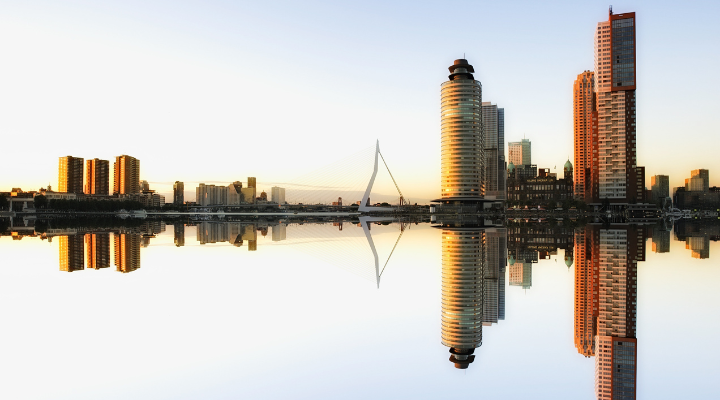
Finally, we look at Rotterdam in The Netherlands which has become increasingly vulnerable to rising water levels due to climate change and is implementing innovative strategies that aim to make the city resilient to water and ensure business continuity.
‘Resilient Rotterdam’, as it has been referred to, has become a role model for other cities across the world looking to be water-resilient because of its 360-approach, which involves the city, its people, businesses, and the environment.
The aim is to ensure that everyone in the city is prepared and can respond effectively when floods occur. The approach includes flood protection measures, improved infrastructure, the construction of water-retention basins, and green roofs.
“A unique aspect of Rotterdam's water resilience programme is its focus on floating infrastructure.”
Located below sea level, Rotterdam has always been vulnerable to flooding, and the city has experienced numerous floods and storm surges. However, it took a catastrophic flood in 1953, in which over 1,800 people died, for Holland to take a radical approach to water management. The country decided to build an innovative flood defense system, the Delta Works, which made Holland one of the most flood-resilient countries in the world.
In recent years, Rotterdam has taken this approach further by implementing a comprehensive water management system to tackle the growing challenges of urbanisation and climate change.
Improving urban environments
Rotterdam's water resilience programme includes several innovative solutions that are transforming the city's relationship with water. For example, the Benthemplein natural playground (below) is a football-field-sized area that absorbs water during heavy rainfall and releases it slowly back into the surrounding ecosystem.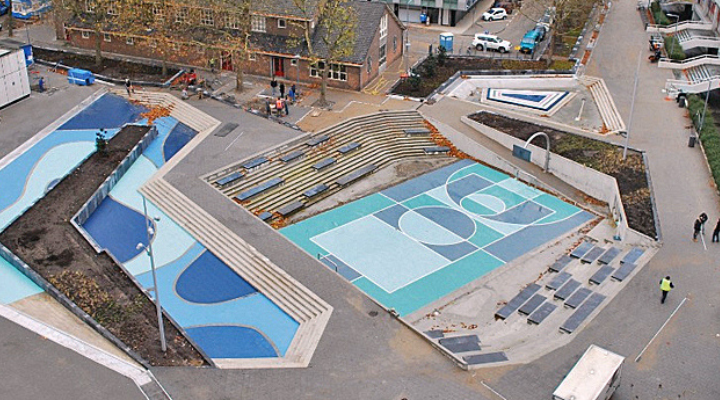
The square has become a recreational space, adding value to the community. Another example is the Water Square, a large urban plaza designed to hold 1,700 m3, which is collected from the square and surrounding streets during heavy rainfall. The Water Square significantly decreases the likelihood of flooding in the city center, while also improving the urban environment and offering a new space for community activities.
A unique aspect of Rotterdam's water resilience programme is its focus on floating infrastructure. As sea levels rise, it's becoming apparent that coastal cities need to adapt to the new realities of climate change. Rotterdam is leading the way by embracing a water-centric urban planning model, which includes a variety of floating structures. The city's Floating Pavilion is a stunning example of sustainable architecture, made entirely out of recycled materials and designed to produce its energy and heat.
“Collaboration and partnerships are critical components of Rotterdam’s success in water reislience.”
Roof gardens have also become a popular trend in urban areas and Rotterdam has taken this concept to another level. The Blue-Green Roof is a unique approach to managing water in urban environments, where green roofs are combined with a blue roof system to collect water. The Blue roof system slows down the flow of water and helps to prevent flooding, while the green roof provides insulation, absorbs pollutants and CO2, increasing biodiversity and improving the urban climate. The Blue-Green Roof is not only a solution to flooding but also a new kind of green infrastructure that provides many co-benefits.
Collaboration and partnerships are critical components of Rotterdam's success in water resilience. The city has formed alliances with other cities and organisations such as the 100 Resilient Cities initiative and the European Union. These collaborations not only help to secure funding for innovative solutions but also promote knowledge exchange and best practices.
Water resilience is a crucial issue for countries and businesses worldwide. The five cities we’ve highlighted have shown water resilience is not a static process but requires ongoing experimentation and improvement.
As we continue to face the impacts of climate change, it is essential that cities continue to take a proactive approach to water resilience to ensure they are prepared for future challenges.
Related content
Share your water technology stories with us
Do you have an innovation, research results or an other interesting topic you would like to share with the international water technology industry? The Aquatech website and social media channels are a great platform to showcase your stories!
Please contact our Sr Brand Marketing Manager Annelie Koomen.
Are you an Aquatech exhibitor?
Make sure you add your latest press releases to your Company Profile in the Exhibitor Portal for free exposure.
We promise never to send you spam and you can unsubscribe at any time!
